Finding Light in a Dark Time
I’ve just returned from PEN International’s 90th World Congress in Oxford, England whose theme was “Writers in a World at War.” PEN originally planned to celebrate its Centenary in Oxford in 2021, but the global pandemic disrupted that gathering. This 90th Congress was co-hosted by English PEN, and while it was smaller than the planned Centenary, there were delegates from 80 PEN centers around the world and 20 more centers represented on Zoom. More than 200 writers participated.
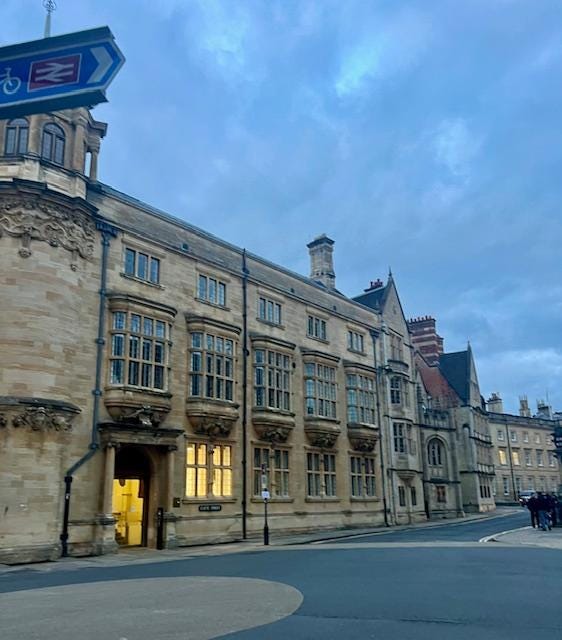
Oxford, England at dusk
PEN International’s congresses have occurred annually except during World War II. The congress is a time when the conversation is live among writers from almost 100 nations in the more than 130 PEN centers. Literature is shared. Formal discussions focus on the challenges for writers at risk, in prison and threatened by authoritarian governments, the challenges of peace and displacement for those in conflict areas, the challenges of linguistic rights and translations and the ongoing challenges for women around the globe. These are addressed through PEN’s four standing committees—the Writers in Prison Committee, the Peace Committee, the Translation and Linguistic Rights Committee, and the Women Writers Committee. At this 90th Congress a new standing committee of PEN International was formed for the first time in 33 years. The committee will develop and give voice to younger writers and is based on the original premise of PEN’s founders for a Tomorrow Club.
PEN operates at both an individual and a global level. The work focuses on the individual writers in prison and at risk in countries such as China, Turkey, Vietnam, Myanmar, Cuba, Guatemala, Belarus, Russia, Egypt, Iran and others. Members write to their fellow writers in prison, to their governments, to the members’ own governments; they lobby on the writers’ behalf, celebrate their writing which the government has suppressed. At a global level PEN International speaks out at the United Nations Human Rights Commission and other forums seeking and urging pathways to free expression and to peace.
This later action via the Peace Committee is often more challenging and taxing to PEN’s mandate. PEN International President Burhan Sönmez noted, “War is the darkest word in every language. While peace is the longest word. Because it never comes to an end in any language.”
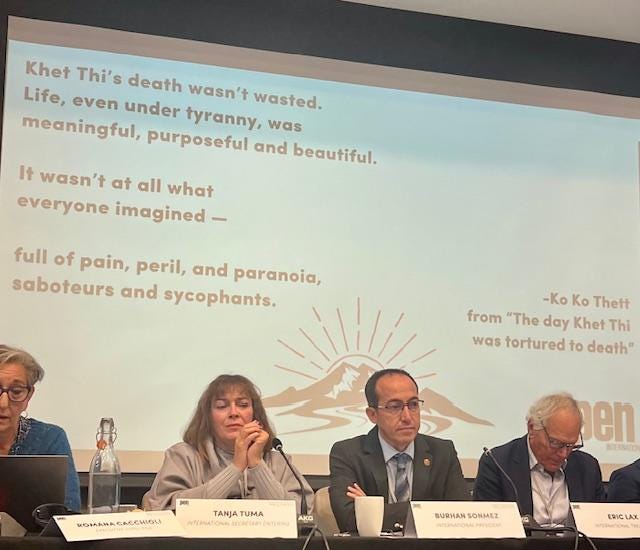
PEN International: (L to R) Executive Director Romana Cacchioli, International Secretary Tanja Tuma, PEN International President Burhan Sönmez, Treasurer Eric Lax
At the 90th Congress the lines of tension heightened as the issues of peace in Israel and Palestine and Gaza arose. The challenges in the Middle East have tested PEN and its Charter before. PEN’s Charter urges members to “use what influence they have in favor of good understanding and mutual respect between nations and people” and to “do their utmost to dispel all hatreds and to champion the ideal of one humanity living in peace and equality in one world.” At the same time “PEN stands for the principle of unhampered transmission of thought within each nation and between all nations, and members pledge themselves to oppose any form of suppression of freedom of expression….”
One of the panels at the Congress was devoted to PEN’s Charter, which novelist and poet Ben Okri described as “one of the great documents of the century, a foundational document.” Linked here, the PEN Charter was one of the documents studied in the development of the United Nations Universal Declaration of Human Rights. Drafted in the wake of World War I and World War II, the governing principle of PEN’s Charter is that “Literature knows no frontiers and must remain common currency among people in spite of political or international upheavals. In all circumstances and particularly in time of war, works of art, the patrimony of humanity at large should be left untouched by national or political passion.”
How this mandate is fulfilled through resolutions and statements in a time of war as is occurring in the Middle East can challenge members. There are those who resist PEN stepping into geopolitical strategies and those who think PEN must not remain silent on these specific issues. Is peace just the cessation of hostilities or the resistance to those who would oppress? A resolution was finally voted on and passed, though not unanimously but with an understanding that the principles of PEN keep us together.
I quote here the words of former PEN International President, playwright Ronald Harwood, who I had the privilege of serving closely with during our shared terms at the Secretariat and with whom I agreed at the time and still in this more activist era. At a fraught Congress during the war in the Balkans in 1993, Ronny noted to the Congress:
“The world seems to be fragmenting; PEN must never fragment. We have to do what we can do for our fellow-writers and for literature as a united body; otherwise we perish. And our differences are our strength: our different languages, cultures and literatures are our strength. Nothing gives me more pride than to be part of this organization when I come to a congress and see the diversity of human beings here and know that we all have at least one thing in common. We write…We are not the United Nations…We cannot solve the world’s problems…Each time we go beyond our remit, which is literature and language and the freedom of expression of writers, we diminish our integrity and damage our credibility…We don’t represent governments; we represent ourselves and our centers…We are here to serve writers and writing and literature, and that is enough… And let us remember and take pleasure in this: that when the words International PEN are uttered, they become synonymous with the freedom from fear.”
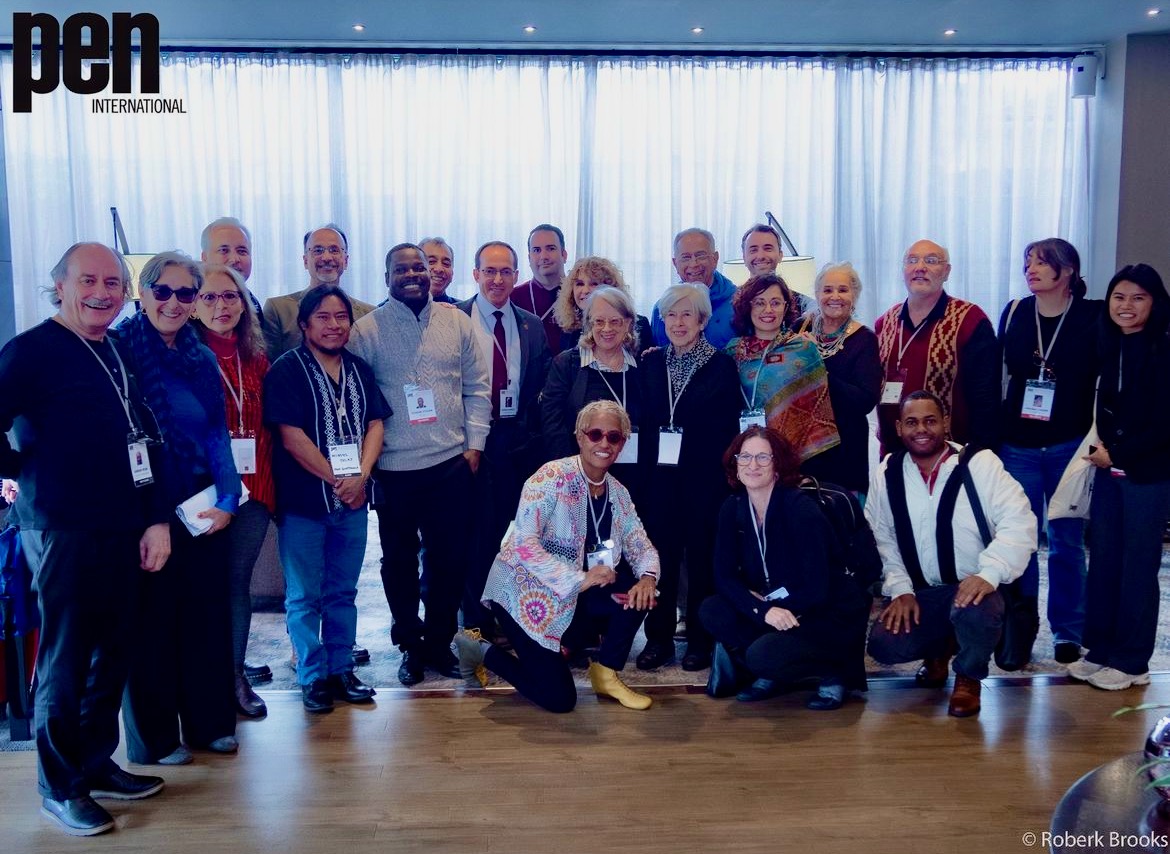
Friends and colleagues at the PEN International 90th World Congress in Oxford, England, September 2024
Join me on Substack
A Moment Past As We Go Forward…
Affirming progress—“We won’t go back…” doesn’t prevent us from remembering and building on the past, acknowledging the ties that bind and helped us make the progress we’ve made and built the foundation from which we launch.
With this in mind, I looked back to a brief moment in time to see what I was thinking and writing in my September blog ten years ago in 2014. I can’t help but reflect on the illusion of time—how fast it moves (or appears to move) and how we circle within it as it wraps itself around us, then shoots us forward.
Boston on a Sunday Afternoon
By Joanne Leedom-Ackerman | September 8, 2014 |
The sun is shining. The swan boats are cruising on the pond in the Boston Commons. Joggers are jogging along the park. Children are running after ducks; parents are running after children. University students have returned en mass from summer so the hum of young people hums in Boston and its neighboring city of Cambridge, ever the student’s town. People from all backgrounds, speaking Spanish, Vietnamese, Arabic, French, Russian and languages I don’t recognize pass by as I sit on a park bench.
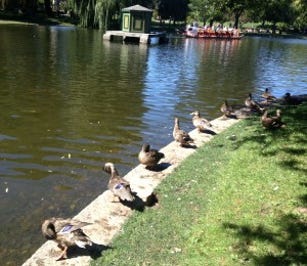
For a moment I don’t want to think about ISIS or terrorists’ attacks or the beheadings of writers, who are friends of people I know, writers and their families whom I can’t help but think about and want to honor, or to think about those who must decide what our country does next or those who will take the risk to do it.
All this is on my mind and on the minds of people in Washington, DC where I live. But for a moment I look out and take a breath and watch Boston on a Sunday afternoon before the world accelerates, a few days before we mark again the events of 9/11. I want to savor and remember this moment just for a moment. It is the point after all.
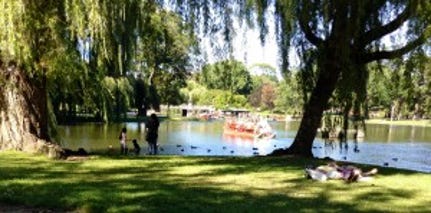
Join me on Substack
Barking at Thunder
After days of sun and blue skies and high, muggy temperatures, the clouds closed in, the sky darkened and the rain came. It was a relief. My morning routine is to get up early and sit outside before the sun starts to bake so that I can gather my thoughts for the day. During a recent storm which began in the night, I sat under the shelter of a side porch to watch the rain fall. My 15-pound, very smart, very fast Australian labradoodle Amie sat beside me.
As the sky darkened further and the rain fell harder, the thunder began, preceding and followed by lightning. At each roll of thunder, Amie leapt off the chair and ran into the yard barking fiercely at the thunder. She returned wet and satisfied when the sound abated and settled her soggy self back next to me. A few moments later, the thunder roared again louder and closer. Amie leapt to her feet and sprinted into the yard racing towards the river and the assaulting sound, barking at full volume.

“Don’t mess with me!” she seemed to be saying. “I’m not afraid! This is my home!” When the thunder retreated and the lightning blinked in the distance, Amie returned again soaked and settled beside me. After a third foray and defense against the thunder, I decided it was time to retreat inside. Despite her brave response and my enjoyment watching her and the storm, I take lightning seriously and decided the spectacle of a brilliant summer storm wasn’t worth the risk close-up. We watched the rest from the house with Amie at her post by the window and my morning thoughts unspooling on the sofa inside.
Barking at Thunder seems an apt description for our response to danger and the unexpected these days. My brave dog has no idea where the sound comes from, what it represents or how little damage thunder itself can do. Likely she doesn’t even see or register the lightning which is the danger. More to the point, she has no idea how irrelevant barking at the noise is, but her instinct is to protect and defend. The sound is fierce, even awe-inspiring so she responds in the way she knows.
The response to fear can often be as ineffectual as barking at thunder. I will resist taking this metaphor any further and leave it for readers to expand any wisdom or relevance it may have. I end with facts and advice on the literal example, not the metaphor, from the National Weather Service.
Happy summer…or winter depending on your hemisphere!
According to the National Weather Service:
Thunder is the sound caused by a nearby flash of lightning and can be heard for a distance of only about 10 miles from the lightning strike. The sound of thunder should serve as a warning to anyone outside that they are within striking distance of the storm and need to get to a safe place immediately!
Thunder is created when lightning passes through the air. The lightning discharge heats the air rapidly and causes it to expand. The temperature of the air in the lightning channel may reach as high as 50,000 degrees Fahrenheit, 5 times hotter than the surface of the sun. Immediately after the flash, the air cools and contracts quickly. This rapid expansion and contraction creates the sound wave that we hear as thunder.
Although a lightning discharge usually strikes just one spot on the ground, it travels many miles through the air. When you listen to thunder, you’ll first hear the thunder created by that portion of the lightning channel that is nearest you. As you continue to listen, you’ll hear the sound created from the portions of the channel farther and farther away. Typically, a sharp crack or click will indicate that the lightning channel passed nearby. If the thunder sounds more like a rumble, the lightning was at least several miles away. The loud boom that you sometimes hear is created by the main lightning channel as it reaches the ground.
Since you see lightning immediately and it takes the sound of thunder about 5 seconds to travel a mile, you can calculate the distance between you and the lightning. If you count the number of seconds between the flash of lightning and the sound of thunder, and then divide by 5, you’ll get the distance in miles to the lightning: 5 seconds = 1 mile, 15 seconds = 3 miles, 0 seconds = very close.
Keep in mind that you should be in a safe place while counting. Remember, if you can hear thunder, chances are that you’re within striking distance of the storm. You don’t want to get struck by the next flash of lightning.
Join me on Substack
Eyes On Pluto
With fraught political climates on the ground in many countries—at least 64 countries face elections this year with democracies in the balance—and with discourse often less than inspiring, I find myself looking up and into the clouds and the sky above for an uncluttered view. That instinct was further encouraged by a book I recently read and note in the Books to Check Out section of this Substack—David Ignatius’ Phantom Orbit. Even before reading this novel, I was recalling a major event in July nine years ago when the New Horizons spacecraft built by Johns Hopkins University’s Advanced Physics Lab gathered data and reported back from Pluto.
As a Hopkins trustee, I was privileged to watch the encounter along with others at the Advanced Physics Lab when the spacecraft reported from its Pluto orbit. “We’re in lock with telemetry with the spacecraft.” A cheer erupted! I re-publish here the story of the event which I still find stirring. The precision of calculations is astonishing, the vision expansive, and the cooperative effort and possibilities for the future inspiring.
Space is considerably more crowded nine years later and much has transpired. Space remains an open territory though one that we must hope doesn’t become clogged with earthbound conflicts and competitions.
EYES ON PLUTO…“WE DID IT!”
By Joanne Leedom-Ackerman | July 15, 2015
Headlines from earth yesterday heralded the Iranian Nuclear Deal, but some of us were looking skyward. On a small green campus tucked into suburban Maryland at the Johns Hopkins University Applied Physics Lab scientists, engineers, media, friends, family, faculty and board of Johns Hopkins University awaited the report back from Pluto. The New Horizons spacecraft, built by Hopkins APL engineers and scientists, had arrived at the outer planet three billion miles away after a nine and a half year journey. That evening the spacecraft was reporting in after 22 hours of silence while it gathered extensive data as it passed within 7750 miles of Pluto.
The spacecraft, which had been built in a record four years at APL, had traveled at a rate of a million miles/day (between 31,000-46,000mph depending on its orbit). The evening before it had started downloading data and taking pictures in a rapid collection of scientific information. It couldn’t do that job and call home at the same time so its progenitors waited anxiously at Mission Control, aware that any number of unpredictable events like a pebble size bit of detritus colliding could disrupt and destroy the mission.
“Stand by for telemetry….” Mission Operations Manager (MOM) Alice Bowman alerted. At 8:52:37pm—right on time—New Horizons called home. “We’re in lock with telemetry with the spacecraft,” she affirmed as one by one the systems managers reported: “MOM, propulsion is nominal…MOM, thermal is nominal…MOM, power is nominal…” Nominal meant normal. MOM meant Alice. The conclusion: “We have a healthy spacecraft and we’re outbound for Pluto!” The room at Mission Control and in the auditorium nearby burst into cheers and tears and gave a standing ovation. It was a remarkable moment and extraordinary achievement.

This composite of enhanced color images of Pluto (lower right) and Charon (upper left), was taken by NASA’s New Horizons spacecraft as it passed through the Pluto system on July 14, 2015.
The mission had proceeded like clockwork. It had been a team effort over a decade and a half, occupying 2500 people. The very best scientists and engineers built the space craft, designed its scientific mission (including the first student-designed project on a NASA mission), programmed its course. The trajectory included an important scientific data-gathering pass of Jupiter, where the spacecraft received a needed gravity assist which sent it hurling on its way into deep space.
New Horizons arrived at the closest approach to the planet just 72 seconds early. That precision over nine years and three billion miles was almost impossible to comprehend except to the scientists and engineers who understood that precision was essential to accomplish the task. Even a small margin of error projected over that amount of time and space could be disastrous.
The mission exemplified a remarkable achievement of teamwork and partnerships among NASA, universities, and the U.S. Department of Energy which supplied the plutonium power source. The nuclear power it provided will allow the spacecraft to operate until 2030. The total power draw for the Pluto encounter was only 202 watts (about three and a half light bulbs). Each transmission draws only 28 watts (enough to power two small night lights.) Reception of these transmissions relies on super giant receivers—the Deep Space Network. There are only three in the world large enough—one in Madrid, Spain, one in Pasadena, CA in the US and one outside Canberra, Australia. The placement of them means that data can be received at any time as the earth spins on its axis. Last night’s transmissions were broadcast from Pluto four and a half hours before they were received, traveling at the speed of light and sent via the giant antenna dish in Madrid.
Alan Stern, the head of the New Horizons Mission and NASA’s chief investigator, told the gathering: “We did it! One small step for New Horizons, one giant leap for mankind.”
The audience included students who had been born almost ten years before on the day of the New Horizons launch. An elementary school boy asked, “Does this make Pluto a planet?” Fran Bagenal, NASA team leader for plasma investigations on the Mission, answered, “Yes! Of course Pluto is a planet!”
The Pluto mission began as a barroom bet by Alan Stern to prove Pluto was not just a dwarf planet but a full planet. The exploration was affirmed as a top priority by the National Academy of Science. In the audience last night were the grown children of Claude Tombaugh, the astronomer who originally discovered Pluto. Eighty-five years earlier their father told his senior astronomer, “I think I have found your planet X.”
Fifty years before to the day—July 14—humans first explored Mars with NASA’s Mariner 4. John Casani, special assistant to the director at NASA’s Jet Propulsion Laboratory (JPL) and one of the early engineers in the space program noted, “People developing spacecraft today know what they are doing. We didn’t know what we were doing. Back then the shoulders we were standing on were too narrow and our shoes were too big. We had only the technology for guided missiles.”
The scientists and engineers had to figure out, among other concepts, 3-axis stabilization. “Innovation was the key to making things work,” Dr. Casani said. “There was no book on 3-axis stabilization. We were all only a couple of years out of graduate school. We weren’t experienced enough to know that what they were asking us to do couldn’t be done.”
“You couldn’t go to the library and ask for a book,” added Norm Haynes, who was the trajectory engineer for the Mariner 4 Mission and also spent his career at NASA’s JPL. “There were no textbooks on how to build a spacecraft.”
There were no computers on board the first spacecrafts either. In 1962 the computer had only a 65,000-word vocabulary as opposed to the multiple gigabytes of memory today. The first computer was aboard Mariner 4 which delivered 22 pictures of Mars, each taking ten hours to send back. It took 60 hours to go to the Moon, 6,000 hours to go to Mars and now the New Horizons spacecraft can endure a nine and a half year journey to Pluto and still arrive in tact. The per mile cost of New Horizon was 25 cents/mile; the per mile cost of Columbus was $3000/mile and the per mile cost of Magellan was $5000/mile. On Mariner 4 in 1965 the spacecraft transmitted information at 8 1/3 bits / second; New Horizon transmits at 1000 bits/second and it is 60 times further away.
The scientists and engineers said the key to success was the willingness to imagine, to innovate and to be willing to fail. Considerable failures preceded this achievement.
Why is the exploration of Pluto important? It opens up our view of what is possible, of the universe and perhaps even of ourselves, suggesting larger horizons physical and metaphysical. It demonstrates the possibilities of human potential—of imagination and ingenuity empowered by cooperation, teamwork and a large goal. From a scientific point of view, from the point of view of NASA which has to secure the funding, it provides knowledge about the universe where we live and the universe beyond.
The data that will be gathered on the New Horizons’ close approach to Pluto is about 100 times more than can transmit before the spacecraft flies away. It will take 16 months to send all the scientific information home.
“We explore because we are human, but we want to know,” said noted physicist Stephen Hawking in a call-in message to the gathering.
If the next stage is funded, the New Horizons spacecraft will go off to explore the outer reaches of the Kuiper Belt, letting us know what lies beyond Pluto in the further reaches of space.
The spacecraft was built to last. Its power will endure until 2030, then it will not be sufficient to keep the instruments warm enough to operate, and the craft will drift into deep space. By 2030, the equipment on the spacecraft will be 40 years old and the innovations that will have developed by then we can now barely imagine.

Credits: NASA/Johns Hopkins University Applied Physics Laboratory/Southwest Research Institute
Join me on Substack
Calm Before and During the Storm
Poised on the threshold of summer, of university protests and disrupted graduations, of US political conventions in July and August, of threatening weather with tornados and hurricanes churning on both US coasts and in the middle of the country, I pause in a patch of early morning sun to savor and seal a moment of calm.
Though I won’t be at the political conventions—may even be out of the country for one of them—and will hopefully miss the worst of summer weather, storms appear on the horizon, and it does no harm to prepare by identifying and fixing one’s North Star.
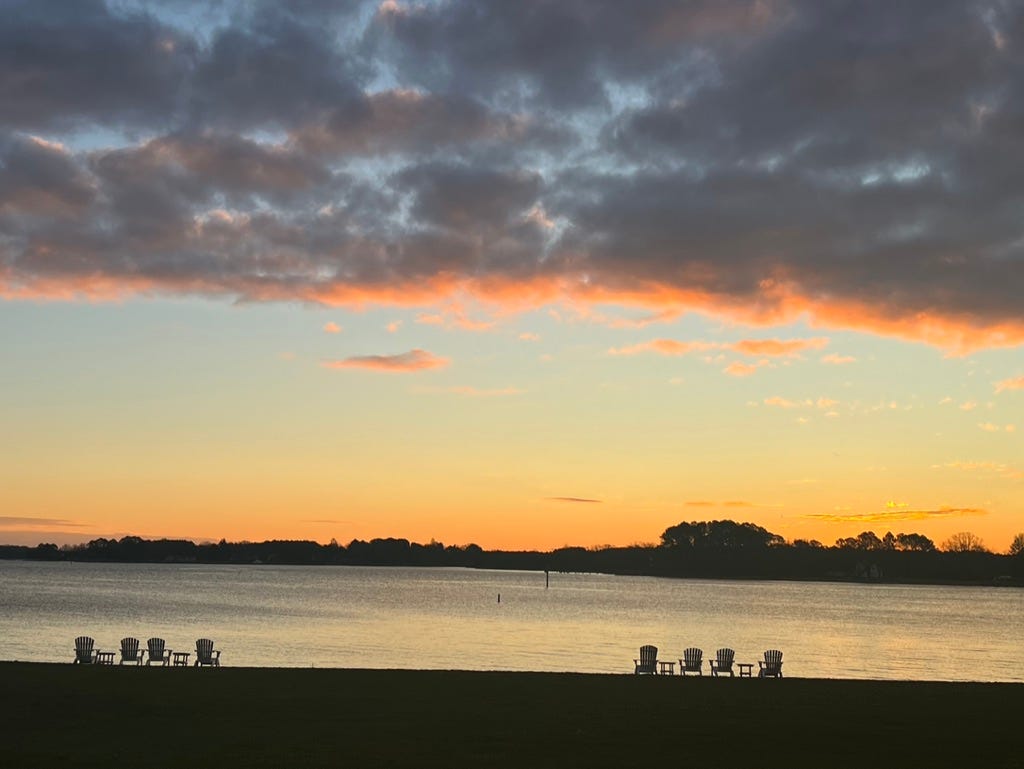
Photo credit: Joanne Leedom-Ackerman
Before the arguments begin or untruths unfurl, or provocations proliferate among the citizenry or even in one’s own family during the US election season, I pause in gratitude that we are allowed to disagree and even protest nonviolently. I am grateful when journalists I know and those I read and listen to work to uncover facts and report in an unbiased fashion. These, however, are not my North Star. I rely instead on a more transcendent light, lodged deeper in a universe that moves towards harmony. I see evidence of this harmony in people caring for each other in the smallest details, in strangers who regularly hoisted my heavy suitcase filled with books and papers into the overhead for me as I traveled on a book tour, in the Uber driver originally from Uzbekistan who stopped en route in NYC to buy me a bottle of water. Small kindnesses we offer each other are the fabric of our citizenry and the evidence that we can be and continue to evolve into a more perfect union.
In the most intractable conflicts between nations, it is the citizens who inevitably must find peace with each other, and perhaps it is with the citizens that the seeds of peace can begin to grow even when politicians are deadlocked. I recall stories from the Balkans War in a memoir Worlds Apart by Ambassador Swanee Hunt. I quote here from the review I wrote in The Christian Science Monitor a decade ago, along with a link to the full article.
The city is surrounded. Shelling rains down on the population. Sniper fire, bombs, mortars erupt from all directions. There are no safe havens for civilians; dozens are killed each day. The international community meets, protests, debates what should be done. Powerful players like Russia obstruct action. Sanctions are tightened, but it is citizens who suffer most. Outside nations are willing to offer humanitarian aid, but are conflicted about arming the opposition. The UN organizes peacekeeping forces, but the mandate and rules of engagement are unclear. The siege and the deaths continue … for years.
This description could be from today’s headlines in Syria, but instead it is the siege of Sarajevo in Bosnia 20 years ago. The paralysis of the international community to intervene and prevent the killings of citizens is still haunting.
In Worlds Apart, former Austrian Ambassador Swanee Hunt chronicles her years (1993-1997) on the inside and the outside of the corridors of war in Bosnia. As the US Ambassador located in Vienna, she sat at embassy dinners, met with European and US government officials, engaged in countless discussions of what should be done. She also used her position, both geographic and political, to visit with the citizens of Bosnia dozens of times in the country and to bring citizens outside the country to meet with each other….
I hope you’ll read the full review linked above and also the book.
And so I will continue to pause in the mornings and savor the light and the promise and endeavor to add my own small and large kindnesses along the way.
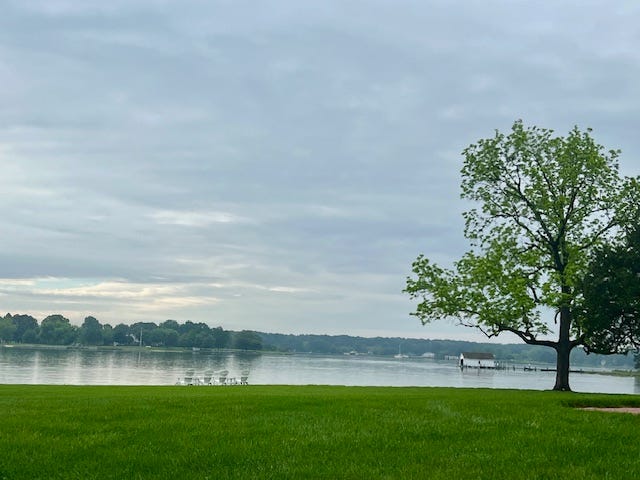
Photo credit: Joanne Leedom-Ackerman
Join me on Substack
Bridges Through Literature
In the early years of this century—2004-2007—I was elected the International Secretary of PEN International, a position at the time responsible for overseeing the running of the day-to-day operations of the global organization, along with a small staff. (During my term we hired the first paid executive director.) PEN’s international organization includes four standing committees—the Peace Committee, the Writers in Prison Committee, the Translation and Linguistic Rights Committee and the Women Writers Committee.
Because I’d been Chair of the Writers in Prison Committee, which oversees the human rights activities of PEN and takes action in defense of writers in prison and at risk around the world, I understood this committee’s work and mandate. I understood the work and mandate of the Translation and Linguistic Rights Committee to defend minority languages and promote the translation of literature globally. And as one of the founding members of the Women Writers Committee which opened up representation by women in PEN and globally, I understood its mandate.
But the Peace Committee always seemed to me more ethereal and abstract. As writers we were not usually at the peace tables, though unfortunately at that time certain writers in the Balkans had helped foment the conflict. Besides passing resolutions for peace and hosting symposiums, what actions could the committee take? One idea of mine, which never did operationalize, was that writers on opposite sides of a conflict could read each other’s best work—not political or polemical work—but the best literature which deals with the human heart and aspirations.
What if Palestinian PEN chose one of the best writings by a Palestinian writer and Israeli PEN read and discussed it, and Israeli PEN suggested a book by one of its best writers and the Palestinian PEN members read and discussed it? Would that open corridors of thought and conversation?
I concede now the rather naive and utopian concept, but to move this utopian vision further into the clouds, what if the members of the two centers could meet and discuss the works as fellow writers! Well, not all dreams come true. Especially when formulated by someone outside of the conflict zone and insulated from the intense emotions and realities on the ground. I admit idealism is not always helpful.
But PEN is an organization of writers, not of politicians or military strategists. As writers we have the luxury and the responsibility to look deeper into the human spirit to find what binds us, to see bridges where others only see chasms.
At the height of the war in the Balkans in 1993, PEN International held its 60th global Congress in Santiago de Compostela, Spain, where the presidency of the organization passed hands from Hungarian novelist György Konrád to British playwright Ronald Harwood. The Balkans War was in full conflict then. Salman Rushdie visited that Congress. At that Congress I was elected Chair of PEN International’s Writers in Prison Committee which brought me into the center of discussions. At the Congress a new Bosnian Center whose members were Serb, Croat and Bosnian was unanimously welcomed as was an ex-Yugoslav Center for writers who no longer lived in the region.
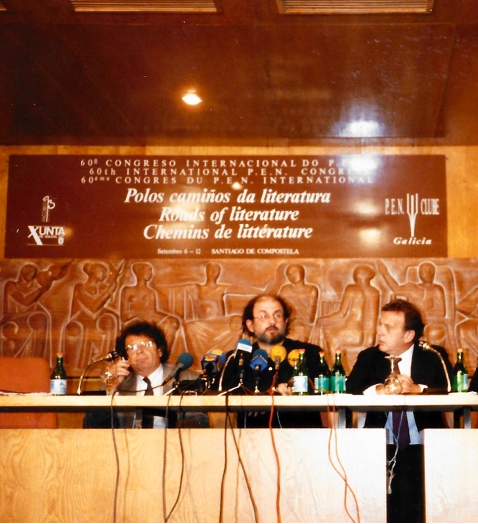
International PEN 60th Congress Assembly of Delegates in Santiago de Compostela 1993. Left to right: György Konrád, Salman Rushdie, Ronald Harwood
The 60th PEN Congress was a watershed of sorts. Konrád’s address at the opening session went a way in bringing the delegates together. “What we can do is to try and ensure the survival of the spirit of dialogue between the writers of the communities that now confront each other….International PEN stands for universalism and individualism, an insistence on a conversation between literatures that rises above differences of race, nation, creed or class, for that lack of prejudice which allows writers to read writers without identifying them with a community…
“Ours is an optimistic hypothesis: we believe that we can understand each other and that we can come to an understanding in many respects. The existence of communication between nations, and the operation of International PEN confirm this hypothesis…PEN defends the freedom of writers all over the world, that is its essence.”
Ronald Harwood added in his acceptance for the presidency: “The world seems to be fragmenting; PEN must never fragment. We have to do what we can do for our fellow-writers and for literature as a united body; otherwise we perish. And our differences are our strength: our different languages, cultures and literatures are our strength. Nothing gives me more pride than to be part of this organization when I come to a Congress and see the diversity of human beings here and know that we all have at least one thing in common. We write…We are not the United Nations…We cannot solve the world’s problems…Each time we go beyond our remit, which is literature and language and the freedom of expression of writers, we diminish our integrity and damage our credibility…We don’t represent governments; we represent ourselves and our Centers…We are here to serve writers and writing and literature, and that is enough…And let us remember and take pleasure in this: that when the words International PEN are uttered they become synonymous with the freedom from fear.”
These words echo today. Linked here is the fuller account of the 60th Congress, of Rushdie’s visit and of PEN’s wrestling with the issues of the time. In PEN Journeys: Memoir of Literature on the Line is an expanded narrative of at least a third of PEN’s century which I’ve had the privilege of participating in—of its history, of writers’ wisdom, of failed idealism and also achieved visions.
Join me on Substack
Spring Showers…Ideas Blooming…Book Tours in the Rain
Four out of the first six book events for my new novel The Far Side of the Desert occurred in the rain with downpours in two cities. Such is the peril of a March pub date, but better than snowstorms in January. A pleasant surprise was how many friends and new readers showed up anyway. A cozy bookstore on a rainy day or evening has its own appeal.
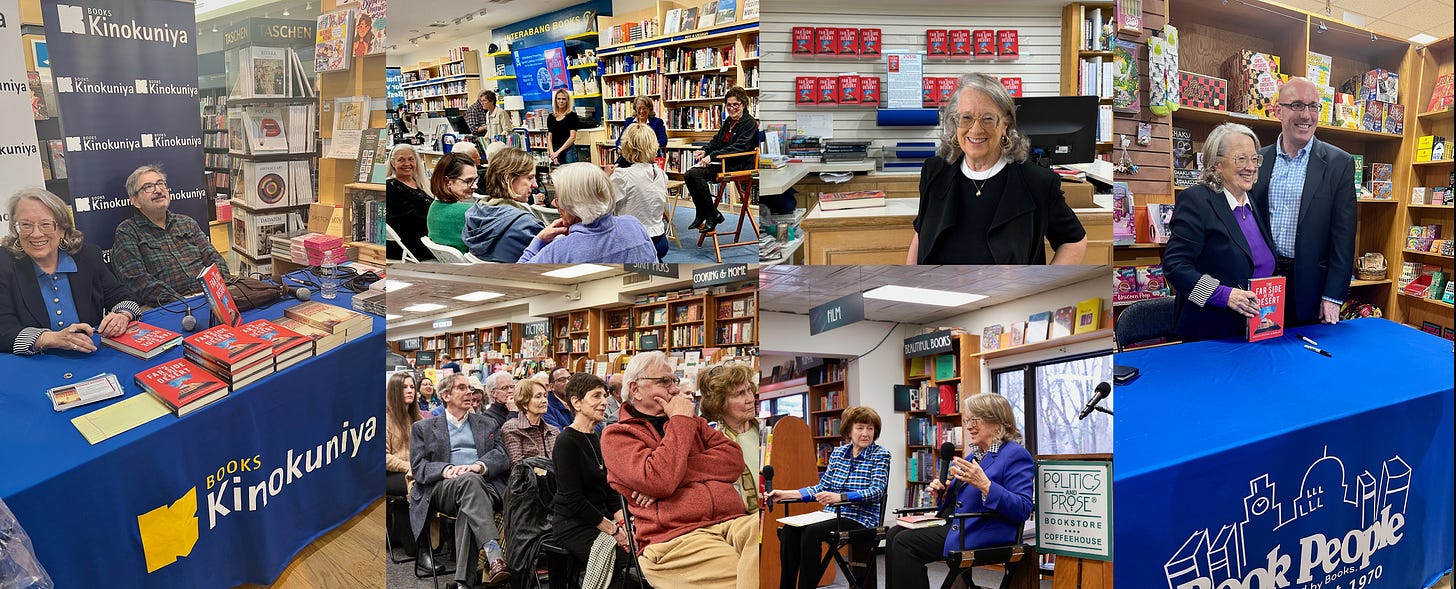
Still on the road, I’m grateful to all those who value books and ideas and friendship and particularly the independent bookstores that host the gatherings. However one comes into contact with ideas and with the experience of others, horizons open and thought expands, both for the writer and the reader. Expanding thought and perceived experience is how we grow.
We are privileged to be able to share books and ideas, a freedom of expression and assembly not to be taken for granted. Ideas are the food of healthy societies, and books are one of the vehicles for these. A tour across the U.S. highlights this privilege which shrinks with censorship and almost disappears if the writer is put behind bars as is the case in too many countries.
Each month in my Substack I feature a writer at risk who is not as fortunate but is targeted by governments threatened by conflicting ideas.
May the power of ideas and imagination and the freedom to write endure and expand.
Join me on Substack
The Far Side of the Desert
July, 2007
A Moorish king and queen bobbed momentarily above Samantha Waters’s scrambled eggs as if waiting to be fed. Outside the second-floor windows of the Hostal dos Reis Católicos, 12-foot puppets of kings and queens and devils and saints peered into the dining room then lurched away toward the square. Samantha leaned over the balustrade and filmed the festivities on the plaza below.
“Let’s go, Monte,” she urged her sister who was hunched over the wooden table with a plate of pancakes. “We can get coffee on the plaza.”
Outside, the smell of coffee and fresh almond cakes rose from pushcarts as pilgrims hurried past shaking tambourines, beating drums and filling the morning air with sound. Somewhere bagpipes played. The sun was already baking the cobblestones in the square where tables and chairs had been set up.
“It’s too crowded,” Monte complained as they merged with a stream of dancers and musicians. “This is a security nightmare!”
“It’s a festival!” Samantha spotted an empty table and tossed her black straw hat over the heads of other spectators to claim it. They’d arrived late last night, she from London and Monte from the U.S. Embassy in Cairo. At breakfast they’d read the guidebook which explained how a monk in the 9th century had discovered the body of the Apostle in a vault in the King and Queen’s home village. The village had been celebrating its destiny ever since….”
So begins my new novel The Far Side of the Desert which comes out March 5 and can be ordered now. It is the story of a diplomatic family, including two sisters and a brother, pulled into the nexus of a global plot when one of the sisters is kidnapped at a festival. No one asks for ransom or contacts the family about her whereabouts or why she was taken. Moving from Spain to Cairo to Washington to London to Morocco to Gibraltar, The Far Side of the Desert is a family drama and a political thriller that explores the links of terrorism, crime, and financial manipulation and the grace that ultimately foils destruction.
I hope you’ll read and be engaged by the story, the characters, and the themes. If you are, I hope you’ll tell friends, write a review, make a little noise.

Like my novel Burning Distance which published last year, The Far Side of the Desert is a story written and re-written over many years.
Shared here is the backstory from the Author’s Note:
I first visited Santiago de Compostela, Spain—the opening scene in The Far Side of the Desert—in 1993 as a delegate to PEN International’s 60th Congress. The PEN Congress coincided with the Festival of St. James and the Camino de Santiago where tourists and pilgrims gathered on the plaza in front of the massive Baroque and Romanesque cathedral. The PEN Congress was an entirely separate event, but the festivities overlapped in the square.
Salman Rushdie made a surprise visit to the Congress, one of his first since the fatwa had been issued against him. At that Congress I was elected the Chair of PEN International’s Writers in Prison Committee, the division of PEN that spearheads PEN’s human rights work on behalf of persecuted writers worldwide so I was one of a small group who greeted and shared dinner with Rushdie. I mention these events because it was there I began contemplating what it would be like if one had to disappear or was disappeared, either by choice or coercion. That question is central to the opening of The Far Side of the Desert. What happens when all the familiar props of life are taken away?
There are many events, much research and intertwining threads that develop in The Far Side of the Desert, but the seed of imagination began in Santiago de Compostela and at the end of the Camino on the rugged cliffs of Galicia facing west over the Atlantic. It is here the ancient Romans thought the world ended, a spot they called the Cape of Death because the sun died there and because ships wrecked on the rocks that jutted out into the sea. The Romans saw nothing westward and could imagine nothing but terrors so they declared Non plus Ultra: There is nothing beyond.
Imagining what is beyond, discovering what holds and what falls away is the journey of the two sisters Monte and Samantha Waters who are from an American diplomatic family. The outer frame of the story includes drug and arms trafficking, money laundering, and financial manipulation—a membrane of crime that smothers large parts of the globe. But the core is the characters and the journeys of their hearts and minds.
Join me on Substack
One Voice…One Thought…One Oyster Shell at a Time
Sitting in an easy chair with my laptop desk and computer, I look out over the river on this winter’s day—frozen ground, chunks of ice littering the lawn, an American flag fluttering out the window and four white Adirondack chairs by the water ready for occupants in the spring. The land and the river edged with ice abide as we wait for leaves to fill in the skeletal trees, though the magnolia remains in leafy bloom though without flowers.
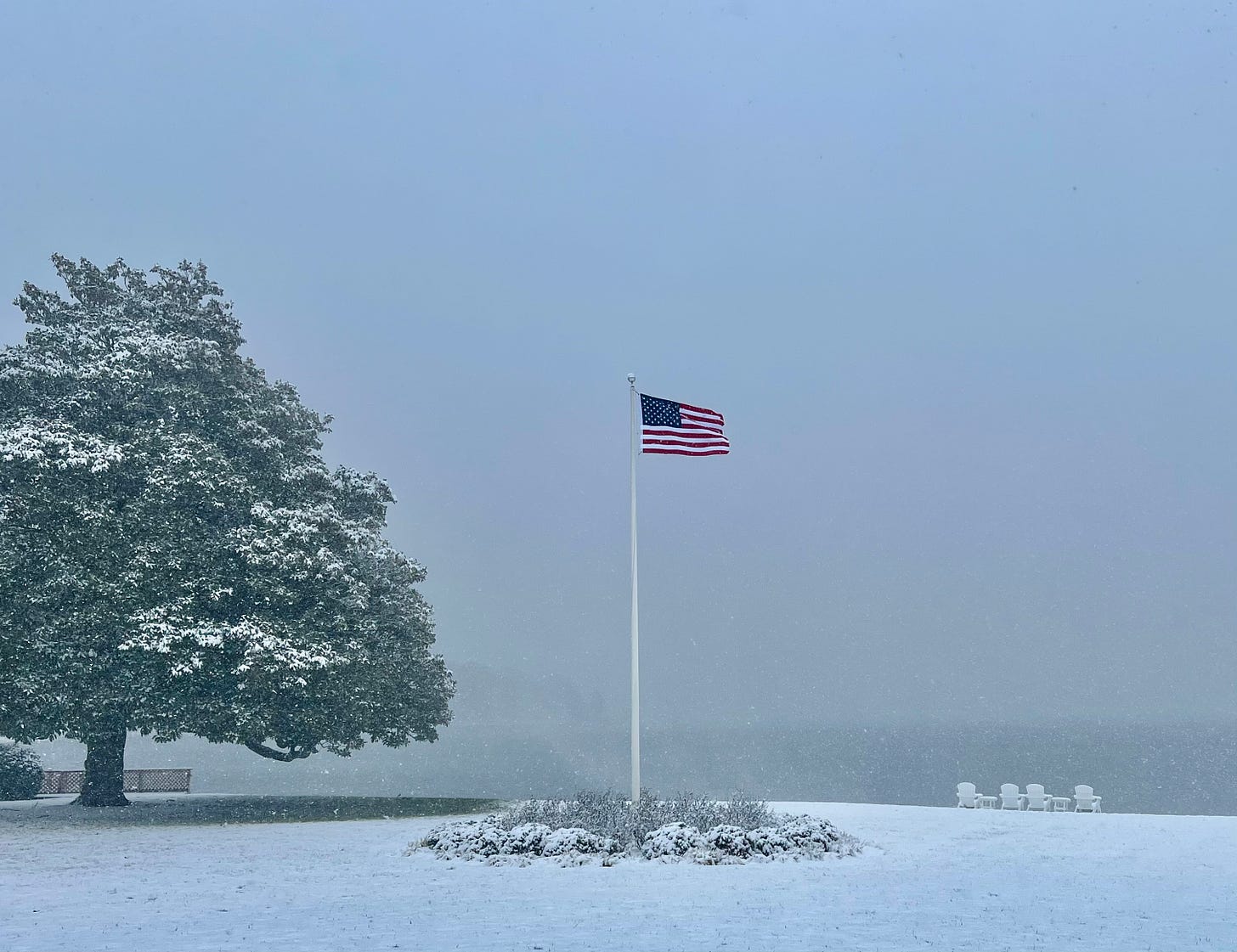
Outside this quiet winter scene, the world continues to roil both at home and abroad. In the US, a presidential election is moving nearer as the first primaries have gotten underway, though certain campaigns have been going on relentlessly as if the campaigning never stopped between elections. It is an exhausting dance of our democracy, and this year is especially fraught. America’s politics this time round feels more like that of some other country’s…maybe Italy’s?—though our system assures whoever ascends to power will likely be ensconced for four years. Our door does not revolve so easily to usher leaders in and out.
One friend distressed by this year’s election decamped to New Hampshire, scene of the second primary, to do what I’m not sure, but to be there and work and participate in this every-four-year process of choosing. That these early choices take place in even colder weather with frozen hard ground and the buds of spring even further away perhaps pays homage to the rugged winters that greeted our earliest forefathers.
As I sit comfortably in my chair, I contemplate what role most of us not directly connected have, both at home and in conflicts abroad. Is it enough to watch from afar, to stay informed? For what purpose and what action?
I was always taught that my thought and my voice mattered. I was responsible for how I thought even if it wasn’t recorded or couldn’t be directly acted upon. How I thought was my responsibility to add beneficence to the global stream of thought. Offering as wise and pure a contribution as I could was like dropping a small purification tablet into the much larger pool. Just as one small tablet can purify 25 gallons of water, a single thought can uplift a community.
I live parttime on the Eastern Shore of Maryland where phalanxes of citizens work to keep the rivers clean so they and their children can rely on the rivers for fish and crabs and their children can swim in the waters, but it takes work by the citizenry. One of the facilitators helping purify the waters are the oysters that live in the rivers. A single oyster can filter 50 gallons of water a day, straining out the impurities. In the 1600s when John Smith first sailed down these rivers, the waters of the Chesapeake renewed with fresh water every two or three days. Now it is more like every 600 days, according to the Shore Rivers project which works to clean up and keep clean the rivers of the Chesapeake.
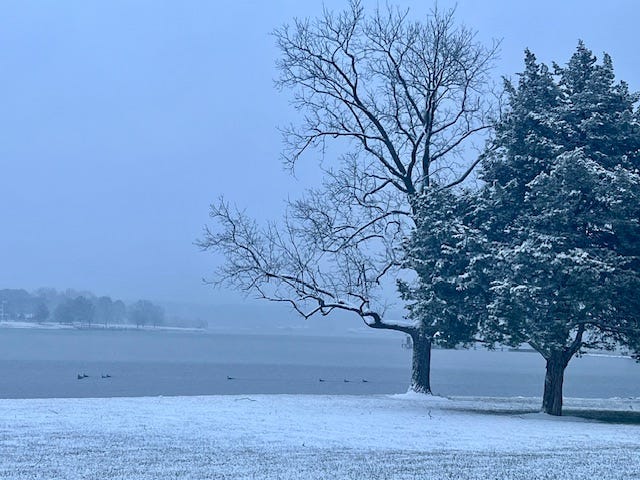
One oyster purifying 50 gallons of water each day! It is a remarkable dynamic. A successful project has been launched to repopulate the rivers with oysters, just one of many methods to clean the rivers. The effort is paying off.
At the risk of stretching the comparison, it is interesting to consider how one’s individual clear, honest, caring, selfless thought might purify a community of thought, dissolving and straining out anger, recrimination, untruths, vitriol, excessive grievances…whatever the issues of polity might be.
In the river I look out on, oysters have been growing on the bottom and are purifying the water daily. I carry hope that we citizens too can clean up the muck in the discourse and fabric of our individual lives, community, and globe one thought, one oyster shell at a time.
Join me on Substack
On the Move—New Year, New Day, New Thoughts…
Nobel physicist Albert Einstein advised: “We cannot solve our problems with the same thinking that created them,” and he urged a new way of thinking. Embedded in the advice was the challenge to understand what that thinking was. Einstein was considering the state of affairs after a world war and the devastation of atomic bombs as citizens sought ways to assure peace in the future.
The advice resonates both at a global and personal level. I’ve heard the story of a highly successful coach who instead of getting angry when one of his athletes made a mistake, would ask: “What were you thinking?” in the hope the individual might self-correct.
Thinking is where action launches and is what determines its direction and often its success or failure.
As the new year begins, we’re lured into resolutions, some we’ll keep, but many we may not even remember the following year. If we could at least not repeat mistakes with circular thinking and instead listen to thinking that leads to solutions, we might be on our way.
In considering this new year’s post, I reviewed my January blogs from the last 15 years. They are a small geo-chronological slice of observations, not always tracking progress but opening a window onto a world looking for answers.
(You can click on each title to if you want to read the whole.)
January 2009: When the Crowds Go Home, Ideas Keep Traveling:
The crowds have left; the reviewing stands disassembled. The reflecting pool is frozen with sea gulls light-footing across it. Washington, DC has held its grand party. For three days, everyone was on foot, bundled in coats, scarves, gloves and walking everywhere–to the Mall, to the Capitol, to the White House (or as close as one could get), peering over barricades, hundreds of thousands of people.
Most of those who came to town have returned to all the states in the union from which they came. Those from the more than 100 foreign countries here to watch the Inauguration have also returned. As the full working week commenced in Washington, snowflakes were falling; the sky was cloudy, and the Potomac River, crusted with ice at the edges, waited for spring.
But the spirit remained. And the consequences of this global gathering were only beginning. Among those visiting Washington were women from the world’s conflict regions, women engaged in peace building, who were gathered to share experiences and also to study and watch the U.S. electoral process, particularly as it might apply to their circumstances and lives….
[After the Inauguration of President Barack Obama]
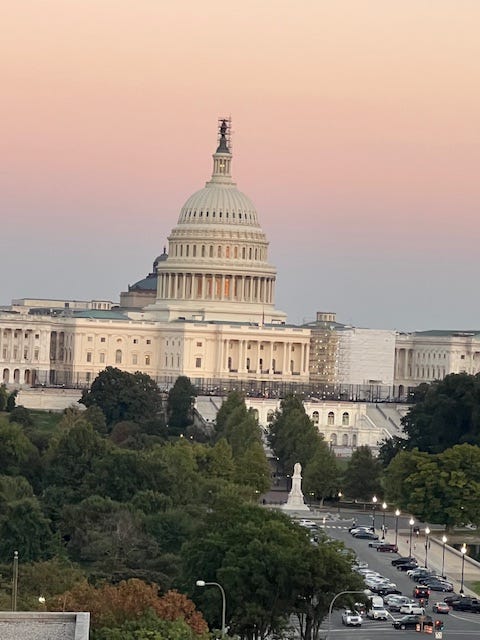
January 2010: Haitian Farewell:
I met Haitian writer Georges Anglade, a bear of a man with a curly gray beard, in the Arctic Circle, in Tromso, Norway in 2004. He spilled a glass of red wine on me. We were at the opening reception of International PEN’s Congress, and whether we were moving in the same or opposite directions around the hors d’oeuvres table or he was gesturing with enthusiasm with his wine glass in his hand, I no longer remember; but the flow of wine down my black suit we both remembered every time we saw each other in the years that followed. It bound us in a moment of surprise and laughter and a kind of instant friendship as if I had been christened by him….
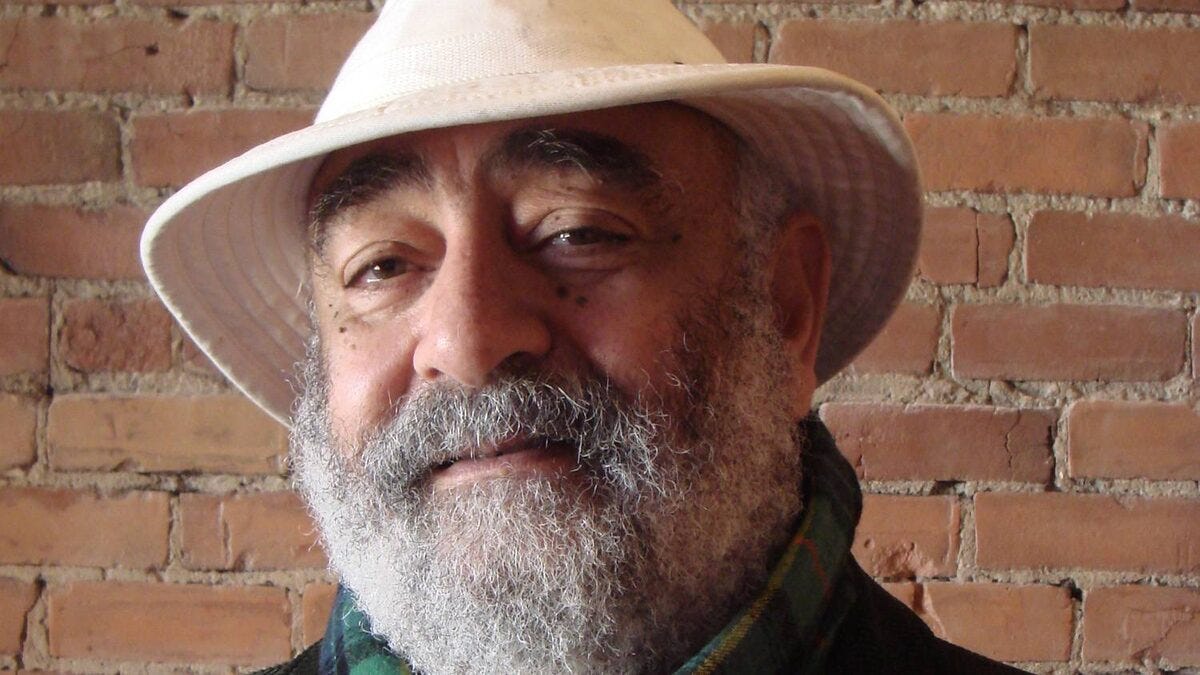
[Memory after the Haiti earthquake of 2010 that killed writer and Haitian PEN President Georges Anglade]
January 2011: Ice Flows: Freedom of Expression:
The Potomac River in Washington is frozen, though only with a light crust of ice, not like the Charles River in Boston which appears a solid block that one might stomp across all the way to Cambridge, though in the center a soft spot could crack open at any moment. Measuring the solidity of surfaces can be a matter of life and death.
The image of frozen surfaces arose as I was reviewing for a talk the appeals sent on behalf of writers in prison or killed for their work in the past year….
January 2012: Voices Around the World:
I began this blog four years ago with modest ambition. Once a month I would pause from writing fiction or other work and weave disparate threads of the month’s events and my thoughts together and share in this new form: the blog post. The posts have often had international themes and freedom of expression themes because work and life lead me to other areas of the world and because the freedom of the individual to write, speak and think is fundamental, especially for a writer.
By posting a monthly blog I also sought to join the 21st century in digital form, but the digital century is rushing so fast that a website with a blog post seems almost obsolete. (By next month I hope to have joined, or at least touched, the social media by also posting on an “author’s page” on Facebook.) Whatever the medium, however, the message remains, and the connection of voices around the world has become transformative.
Each month notices of writers under threat come across my desk. I find myself studying the pictures of the writers when there are pictures, writing down their names, and when available, reading some of their work to make them real in my own mind and imagination and later to share their work, which governments hope to silence…
January 2013: Sunrise in Islamabad:
As I leave Washington, DC, the sun is sinking as a gauzy pink globe just beyond the runway. I imagine it about to rise over my destination: Islamabad.
This will be my first trip to Pakistan, a country where I have friends and colleagues, but we always meet outside of Pakistan. For me the country is still a place in imagination. The picture is drawn with many strokes, beginning with media images of bustling streets in Islamabad, Lahore and Karachi, of barren rocky mountain sides in the tribal territories, images of markets and cafes and dark streets in the novels of Pakistani writers, stories of friends’ childhoods, particularly stories of women who at great odds rose to become voices and leaders in the country, and by the headlines of terrorist attacks….
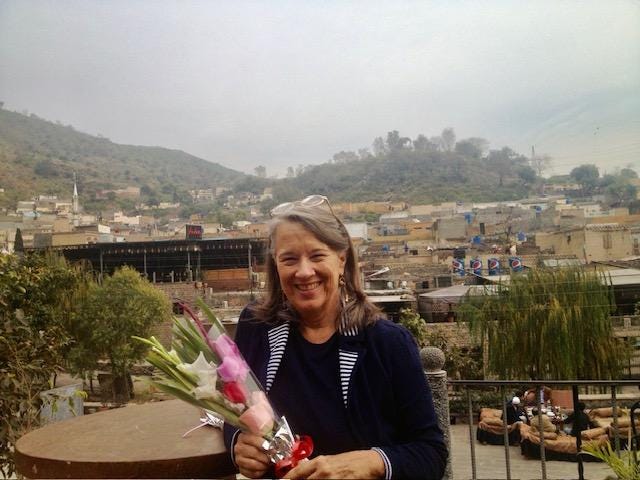
[On a delegation of writers to Pakistan with the International Center for Journalists]
January 2014: Syrian Refugee Tsunami:
We’d come to visit a Syrian refugee camp on the Turkish border. When we arrived in Gaziantep, a bustling ancient city just 30 miles from Syria, we were told by United Nations representatives that a battle was going on across the border that day. A bullet had struck a house in the nearby refugee camp so our visit was canceled for security reasons.
The following day a fuller story emerged. In the Syrian town of Jarabulus just 3km over the border, the battle had been especially brutal. At least 10 men were beheaded and their heads mounted on spikes to terrorize the community. The Syrians from the town were now fleeing to Turkey and away from the al Qaeda-linked fighters.
This particularly grisly battle underscores the horror and tragedy facing the almost nine million Syrians (6.5 million in country; at least 2.3 million outside the country) seeking security. Aid agencies estimate at least half the Syrian population of 22.4 million is in need of humanitarian assistance, and as many as three quarters of the population will be in need of aid by the end of 2014….
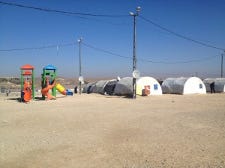
[On a delegation with UNHCR]
January 2015—No blog posted
January 2016: View on the Bosphorus: Rights in Retreat:
I’m sitting on the Bosphorus today in Istanbul looking across to the Asian side over the balustrade of a European porch. I’ve been visiting Istanbul over the last 20 years for conferences, recently for visits to refugee camps and most often now to see family living here. Istanbul is one of my favorite cities, full of heart, multiple cultures, history and citizens of intellect and warmth.
But recently the atmosphere has chilled. I’ve come on this trip to participate in the launch of Human Rights Watch’s 2016 World Report which focuses on the “Politics of Fear and the Crushing of Civil Society” as causes that imperil citizens’ rights around the world. Istanbul was chosen as the launch city because it sits at the nexus of east and west, is the crossing point for millions of refugees fleeing the Syrian war and has an active civil society and free press that are now severely tested as the environment for rights deteriorates….
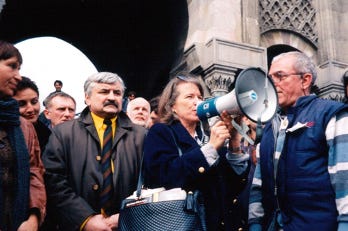
January 2017: Power on Loan:
The first march I covered as a journalist was a massive anti-war moratorium in Boston in the spring of 1970, part of nationwide protests; Boston was one of the hub cities. The demonstrators walked peacefully from the Boston Commons through the city to Harvard Square in Cambridge. But as the day and evening wore on, the demonstration descended into violence in Cambridge with Molotov cocktails thrown through store windows and police dogs and tear gas aimed at the crowds. I took refuge eventually in the basement of a church where I wrote my story.
America was on the march back then against the Vietnam war and in earlier protests in favor of civil rights. Though there was violence, most of the demonstrations remained nonviolent….

[I was a reporter for The Christian Science Monitor covering the protests spring 1970]
January 2018 and 2019—No January blog posted
January 2020: PEN Journeys 16 and 17:
PEN International celebrates its Centenary in 2021. I’ve been active in PEN for more than 30 years in various positions and now as an International Vice President Emeritus. With memories stirring and file drawers of documents and correspondence bulging, I am a bit of a walking archive and have been asked by PEN International to write down memories. I hope this personal PEN journey will be of interest.
PEN Journey 16: The Universal, the Relative, and the Changing PEN:
Fremantle, Australia is far away, at least if you live in the Americas or Europe or West Africa. So is Tokyo, Manila, Nepal, Hong Kong,—all destinations of PEN Congresses and conferences. As a global organization with centers in over 100 countries, PEN tries to cover the world with its meetings and at least once or twice a decade organize a Congress in Asia or Australia with its centers there.
In 1995 for PEN International’s 62nd Congress Perth PENhosted delegates from around the world in Fremantle, a port city on Australia’s western coast in the Perth metropolitan area, a picturesque city with Victorian architecture and, as I recall at the time, a town out of the 1960’s where time hadn’t quite caught up. The city’s reputation was partially derived from its history as a penal colony from the 1850’s to 1991. The traditional Aboriginal people who lived there called the area Walyalup “the crying place.”….

PEN Journey 17: Gathering in Helsingor:
What I remember most about the gathering of colleagues from 28 countries—31 PEN centers—51 of us in all at the first Writers in Prison Committee conference in 1996 was the seriousness of purpose and intellect during the day and the fun and talent in the evenings.
Hosted by Danish PEN, writers from every continent gathered at a university in Helsingør—known in English as Elsinore, the home of Shakespeare’s Hamlet—where we met in workshops and ensemble during the day to shape and refine our work on behalf of writers and freedom of expression around the world. But in the evening we were at a small university in a small city without transportation or distraction so we entertained ourselves. Each delegate displayed talents—from poetry reading to song to dance to musical performances….
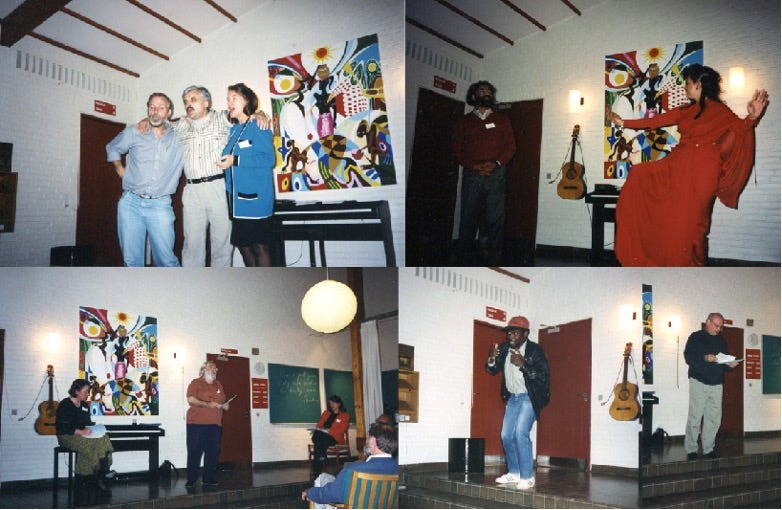
January 2021: New Day…:
I watched the sun rise this morning, the ducks swimming by south to north, the geese flying overhead north to south, the light spreading across the river—first a red strip, then orange…pink…a yellow ball peeking through the grove of trees across the water, then ascending the treetops…a golden globe heralding the day.
The river flows steadily towards an open expanse into the Chesapeake and ultimately into the Atlantic Ocean. It has been a mild winter so far, no ice on the water, just an occasional dusting of frost on the ground which melts with the sun.
On a flagpole by the river the American flag ripples in the breeze as the geese flap by. My dogs—one blonde, one black, both part Labrador and other breeds, wander along the river front, finding their smells and place to rest and watch the day unfold.
It is a new day…with a new government in my home city of Washington, DC….

January 2022: PEN Journeys: Memoir of Literature on the Line:
Publication Day—a combination of birthday, final exam, perhaps wedding day—the day when a book officially launches into the world, though in this pandemic time, the whistles and confetti and celebrations are at least postponed till spring and outside gatherings, but the book itself is on its way to whatever shores and audience will take it in.
PEN Journeys: Memoir of Literature on the Line officially enters the world February 1, 2022, though it has been available digitally on Kindle and AppleBooks for the past month, and at least one bookseller has been shipping as soon as orders were received because the publisher, Shearsman Books, had the books ready early….

January 2023: Waiting for Spring:
The winter solstice has passed, and each day adds two to three minutes of daylight.
The crocus buds have already broken through the soil. So far winter in the mid-Atlantic, at least in Maryland and Washington, DC, has been wet but not freezing though we are not yet safe from frost. I wish the buds would hold off, not be too anxious to pop above the ground. February can still be a fierce month.
In the garden the birds are clustered around the bird feeder for food which is still scarce on the trees. The squirrels have figured out how to tip the feeders and scatter the seeds and grain on the ground so they can run off with it. My dog spends hours at the window watching the squirrels, just waiting to get out to defend her turf. She’s taken the side of the birds which she also watches but allows with more tolerance in her corner of the garden.
She sees a fox and wants to chase after it though she is smaller but just as fast. It is mating season for the foxes, and they disappear into their den.
The early signs of spring are breaking out everywhere. We wait, not always patiently, for the earth to warm, the flowers to bloom, the cubs to emerge and disappear into the woods and for the earth to tilt towards the sun….

Join me on Substack

